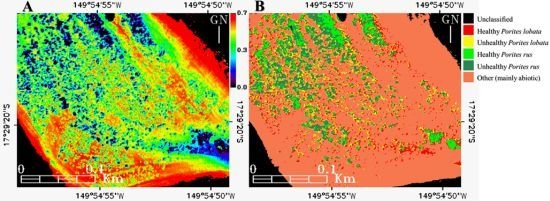Enhancing Coral Health Detection Using Spectral Diversity Indices from WorldView-2 Imagery and Machine Learners
Abstract
:1. Introduction
2. Methodology
2.1. Study Site
2.2. Ground-Truthing
2.3. Image Processing
2.4. Patterns of Coral Spectra
2.5. Spectral Diversity Indices
2.6. Classification
3. Results and Discussion
3.1. Increasing Spectral Bands Involved a Better Discrimination of Coral-Dominated Assemblages and Health State
3.2. Spectral Diversity Indices Enhanced Classification of Coral-Dominated Assemblages and Health State
4. Conclusions
Acknowledgments
References
- Costanza, R.; d’Arge, R.; de Groot, R.; Farber, S.; Grasso, M.; Hannon, B.; Limburg, K.; Naeem, S.; O’Neill, R.V.; Paruelo, J.; et al. The value of the world’s ecosystem services and natural capital. Nature 1997, 387, 253–260. [Google Scholar]
- UNEP/AMAP Expert Group, Climate Change and POPS: Predicting the Impacts; Arctic Monitoring and Assessment Programme: Oslo, Norway, 2011; p. 62.
- Hoegh-Guldberg, O.; Mumby, P.J.; Hooten, A.J.; Steneck, R.S.; Greenfield, P.; Gomez, E.; Harvell, C.D.; Sale, P.F.; Edwards, A.J.; Caldeira, K.; et al. Coral reefs under rapid climate change and ocean acidification. Science 2007, 318, 1737–1742. [Google Scholar]
- Emanuel, K. Increasing destructiveness of tropical cyclones over the past 30-years. Nature 2005, 436, 686–688. [Google Scholar]
- Wilkinson, C. Status of Coral Reefs of the World: 2008. In Status of Coral Reefs of the World; Reef and Rainforest Research Centre/Global Coral Reef Monitoring Network: Townsville, Australia, 2008; p. 304. [Google Scholar]
- Loreau, M.; Naeem, S.; Inchausti, P. Biodiversity and Ecosystem Functioning: Synthesis and Perspectives; Oxford University Press: Oxford, UK, 2002. [Google Scholar]
- Mumby, P.J.; Chisholm, J.R.M.; Clark, C.D.; Hedley, J.D.; Jaubert, J. Spectrographic imaging: A bird’s-eye view of the health of coral reefs. Nature 2001, 413, 36. [Google Scholar]
- LeDrew, E.F.; Holden, H.; Wulder, M.A.; Derksen, C.; Newman, C. A spatial statistical operator applied to multidate satellite imagery for identification of coral reef stress. Remote Sens. Environ 2004, 91, 271–279. [Google Scholar]
- Andréfouët, S.; Cabioch, G.; Flamand, B.; Pelletier, B. A reappraisal of the diversity of geomorphological and genetic processes of New Caledonian coral reefs: a synthesis from optical remote sensing, coring and acoustic multibeam observations. Coral Reef 2009, 28, 691–707. [Google Scholar]
- Hochberg, E.J. Remote Sensing of Coral Reef Processes. In Coral Reefs: An Ecosystem in Transition; Dubinsky, Z., Stambler, N., Eds.; Springer: Amsterdam, The Netherlands, 2011; pp. 25–35. [Google Scholar]
- Elvidge, C.D.; Dietz, J.B.; Berkelmans, R.; Andréfouët, S.; Skirving, W.; Strong, A.E.; Tuttle, B.T. Satellite observation of Keppel Islands (Great Barrier Reef) 2002 coral bleaching using IKONOS data. Coral Reef 2004, 23, 123–132. [Google Scholar]
- Mishra, D.; Narumalani, S.; Rundquist, D.; Lawson, M. Benthic habitat mapping in tropical marine environments using QuickBird multispectral data. Photogramm. Eng. Remote Sensing 2006, 72, 1037–1048. [Google Scholar]
- Mishra, D.R.; Narumalani, S.; Rundquist, D.; Lawson, M.; Perk, R. Enhancing the detection and classification of coral reef and associated benthic habitats: A hyperspectral remote sensing approach. J. Geophys. Res 2007, 112, C08014. [Google Scholar]
- Holden, H.; LeDrew, E. Spectral discrimination of healthy and non-healthy corals based on cluster analysis, principal components analysis, and derivative spectroscopy. Remote Sens. Environ 1998, 65, 217–224. [Google Scholar]
- Hochberg, E.; Atkinson, M.J.; Andréfouët, S. Spectral reflectance of coral reef bottom-types worldwide and implications for coral reef remote sensing. Remote Sens. Environ 2003, 85, 159–173. [Google Scholar]
- Leiper, I.A.; Siebeck, U.E.; Marshall, N.J.; Phinn, S.R. Coral health monitoring: Linking coral colour and remote sensing techniques. Can. J. Remote Sens 2009, 35, 276–286. [Google Scholar]
- Collin, A.; Planes, S. What is the Value Added of 4 Bands within the Submetric Remote Sensing of Tropical Coastscape? Quickbird-2 vs. WorldView-2. Proceedings of the 31st IGARSS, Vancouver, Canada, 24– 29 July 2011.
- Magurran, A.E. Measuring Biological Diversity; Blackwell Publishing: Oxford, UK, 2004. [Google Scholar]
- Laben, C.A.; Brower, B.V. Process for Enhancing the Spatial Resolution of Multispectral Imagery Using Pan-Sharpening. US Patent 6,011,875, 4 January 2000.
- Collin, A.; Archambault, P.; Planes, S. Bridging the coastal habitats: Very high resolution of the seamless tropical littoral using WorldView-2. Remote Sens. Environ 2012. submitted. [Google Scholar]
- Lyzenga, D.R. Passive remote sensing techniques for mapping water depth and bottom features. Appl. Opt 1978, 17, 379–383. [Google Scholar]
- Lyzenga, D.R. Remote sensing of bottom reflectance and water attenuation parameters in shallow water using aircraft and Landsat data. Int. J. Remote Sens 1981, 2, 71–82. [Google Scholar]
- Stumpf, R.P.; Holderied, K.; Sinclair, M. Determination of water depth with high-resolution satellite imagery over variable bottom types. Limnol. Oceanogr 2003, 48, 547–556. [Google Scholar]
- Collin, A.; Hench, J.L. Towards deeper measurements of tropical reefscape structure using the WorldView-2 spaceborne sensor. Remote Sens 2012, 4, 1425–1447. [Google Scholar]
- Maritorena, S.; Morel, A.; Gentili, B. Diffuse reflectance of oceanic shallow waters: Influence of water depth and bottom albedo. Limnol. Oceanogr 1994, 39, 1689–1703. [Google Scholar]
- Jerlov, N.G. Optical Oceanography; Elsevier: Amsterdam, The Netherlands, 1968; p. 194. [Google Scholar]
- Kutser, T.; Miller, I.; Jupp, D.L.B. Mapping coral reef benthic substrates using hyperspectral space-borne images and spectral libraries. Estuar. Coastal Shelf Sci 2006, 70, 449–460. [Google Scholar]
- Siebeck, U.E.; Marshall, N.J.; Kluter, A.; Hoegh-Guldberg, O. Fine scale monitoring of coral bleaching using a colour reference card. Coral Reef 2006, 25, 453–460. [Google Scholar]
- Shannon, C.E.; Weaver, W. The Mathematical Theory of Communication; The University of Illinois Press: Urbana, IL, USA, 1949. [Google Scholar]
- Simpson, E.H. Measurement of diversity. Nature 1949, 163, 688. [Google Scholar]
- Wei, C.-L.; Rowe, G.T.; Escobar-Briones, E.; Boetius, A.; Soltwedel, T.; Caley, M.J.; Soliman, Y.; Huettman, F.; Qu, F.; Yu, Z.; et al. Global patterns and predictions of seafloor biomass using random forests. PLoS One 2010, 5, e15323. [Google Scholar]
- Collin, A.; Archambault, P.; Long, B. Predicting species diversity of benthic communities within turbid nearshore using full-waveform bathymetric LiDAR and machine learners. PLoS One 2011, 6, e21265. [Google Scholar]
- Elith, J.; Graham, C.H. Do they? How do they? Why do they differ? On finding reasons for differing performances of species distribution models. Ecography 2009, 32, 66–77. [Google Scholar]
- Breiman, L. Random forests. Mach. Learn 2001, 45, 5–32. [Google Scholar]
- Congalton, R.G.; Green, K. Assessing the Accuracy of Remotely Sensed Data: Principles and Practices; Lewis Publishers: Boca Raton, FL, USA, 1999; p. 137. [Google Scholar]
- Demšar, J.; Zupan, B.; Leban, G.; Curk, T. Orange: From Experimental Machine Learning to Interactive Data Mining. In Knowledge Discovery in Databases: PKDD 2004; Boulicaut, J.-F., Esposito, F., Giannotti, F., Pedreschi, D., Eds.; Springer: Berlin/Heidelberg, Germany, 2004; Volume 3202, p. 537. [Google Scholar]
- Andréfouët, S.; Payri, C.; Hochberg, E.J.; Hu, C.; Atkinson, M.J.; Muller-Karger, F. Use of in situ and airborne reflectance for scaling-up spectral discrimination of coral reef macroalgae from species to communities. Mar. Ecol.Progr. Ser 2004, 283, 161–177. [Google Scholar]
- Morel, A.; Maritorena, S. Bio-optical properties of oceanic waters: A reappraisal. J. Geophys. Res 2001, 106, 7163–7180. [Google Scholar]
- Brando, V.E.; Anstee, J.M.; Wettle, M.; Dekker, A.G.; Phinn, S.R.; Roelfsema, C. A physics based retrieval and quality assessment of bathymetry from suboptimal hyperspectral data. Remote Sens. Environ 2009, 113, 755–770. [Google Scholar]
- Collin, A.; Hench, J.L.; Planes, S. A Novel Spaceborne Proxy for Mapping Coral Colonies. Proceedings of the International Coral Reef Symposium (ICRS), Cairns, Australia, 9–13 July 2012.
- Bricaud, A.; Claustre, H.; Ras, J.; Oubelkheir, K. Natural variability of phytoplanktonic absorption in oceanic waters: Influence of the size structure of algal populations. J. Geophys. Res 2004, 109, C11010. [Google Scholar]
- Mumby, P.J.; Skirving, W.; Strong, A.E.; Hardy, J.T.; LeDrew, E.F.; Hochberg, E.J.; Stumpf, R.P.; David, L.T. Remote sensing of coral reefs and their physical environment. Mar. Pollut. Bull 2004, 48, 219–228. [Google Scholar]
- Purkis, S.J.; Myint, S.W.; Riegl, B.M. Enhanced detection of the coral Acropora cervicornis from satellite imagery usng a textural operator. Remote Sens. Environ 2006, 101, 82–94. [Google Scholar]
- Clark, C.; Mumby, P.; Chrisholm, J.; Jaubert, J.; Andréfouët, S. Spectral discrimination of coral mortality states following a severe bleaching event. Int. J. Remote Sens 2000, 21, 2321–2327. [Google Scholar]

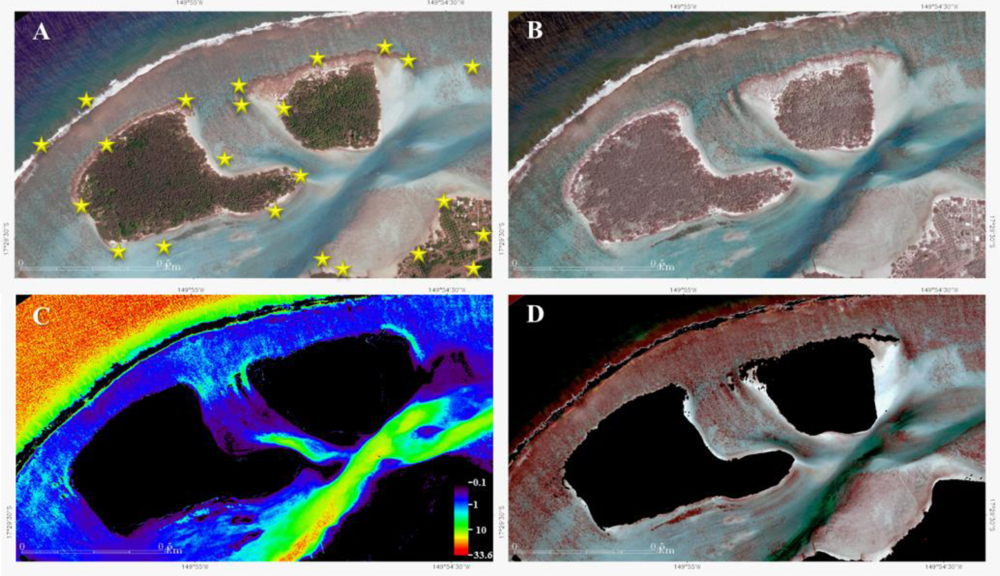
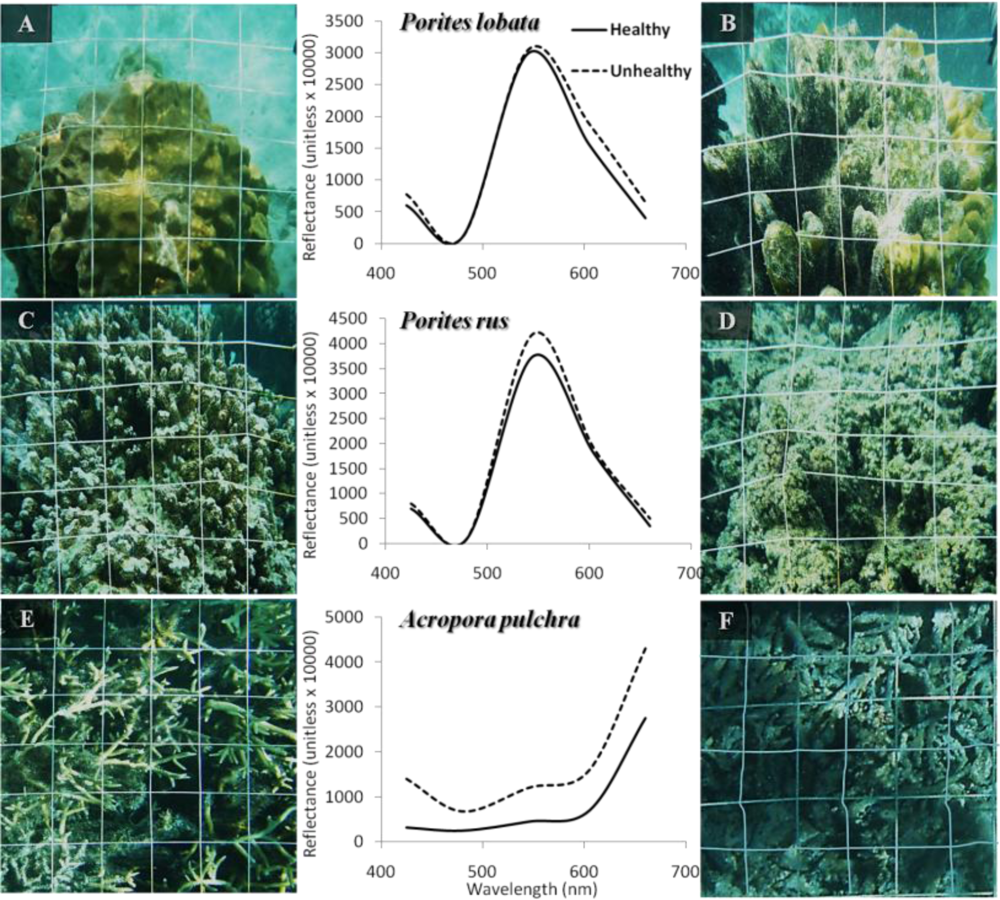
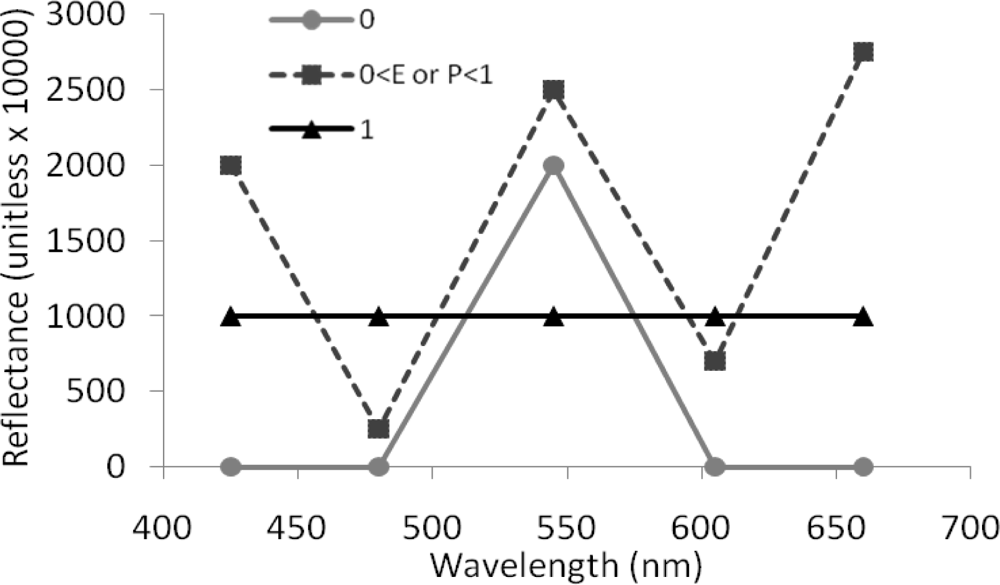
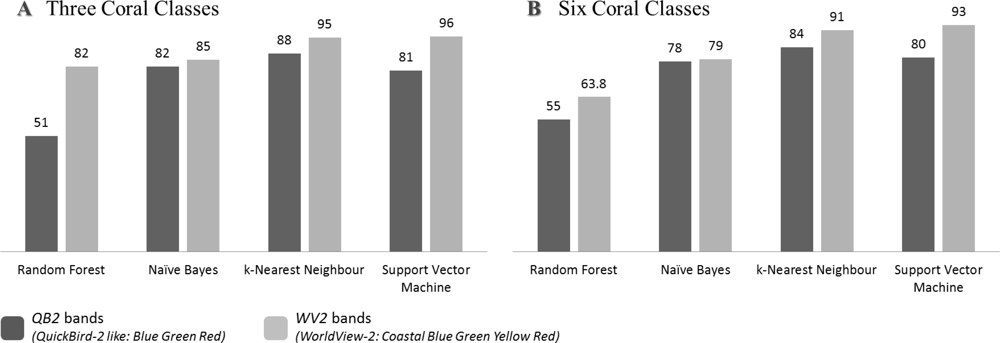




| Waveband Names | Band Number | WV2 Wavelength Range (nm) | QB2 Wavelength Range (nm) |
|---|---|---|---|
| “Coastal” | 1 | 400–450 | |
| Blue | 2 | 450–510 | 450–520 |
| Green | 3 | 510–580 | 520–600 |
| Yellow | 4 | 585–625 | |
| Red | 5 | 630–690 | 630–690 |
| “Red edge” | 6 | 705–745 | |
| Near InfraRed 1 | 7 | 770–895 | 760–890 |
| Near InfraRed 2 | 8 | 860–1,040 | |
| Panchromatic | X | 450–800 | 450–900 |
| Waveband Names | Diffuse Attenuation Coefficients (m−1) |
|---|---|
| “Coastal” | 0.13 |
| Blue | 0.1 |
| Green | 0.11 |
| Yellow | 0.335 |
| Red | 0.5 |
| Pigments | Range (nm) | Index Proposed | |
|---|---|---|---|
| Healthy Porites lobata | ca, cc, p, d, β | 400–690 | E123, E35, E45 |
| Unhealthy Porites lobata | ca, cc, p | 510–690 | E35, E45 |
| Healthy Acropora pulchra | ca, cc, p, d, β | 400–580 | E123 |
| Unhealthy Acropora pulchra | |||
| Healthy Porites rus | ca, cc, p, d, β | 400–580 and 630–690 | E12, E123, E35 |
| Unhealthy Porites rus | ca, cc, p, d, β | 400–510 and 585–690 | E12, E45 |
Share and Cite
Collin, A.; Planes, S. Enhancing Coral Health Detection Using Spectral Diversity Indices from WorldView-2 Imagery and Machine Learners. Remote Sens. 2012, 4, 3244-3264. https://doi.org/10.3390/rs4103244
Collin A, Planes S. Enhancing Coral Health Detection Using Spectral Diversity Indices from WorldView-2 Imagery and Machine Learners. Remote Sensing. 2012; 4(10):3244-3264. https://doi.org/10.3390/rs4103244
Chicago/Turabian StyleCollin, Antoine, and Serge Planes. 2012. "Enhancing Coral Health Detection Using Spectral Diversity Indices from WorldView-2 Imagery and Machine Learners" Remote Sensing 4, no. 10: 3244-3264. https://doi.org/10.3390/rs4103244
APA StyleCollin, A., & Planes, S. (2012). Enhancing Coral Health Detection Using Spectral Diversity Indices from WorldView-2 Imagery and Machine Learners. Remote Sensing, 4(10), 3244-3264. https://doi.org/10.3390/rs4103244



